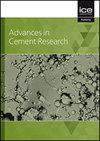含活化铁尾矿粉混合水泥的性能与微观结构
IF 1.3
4区 工程技术
Q3 CONSTRUCTION & BUILDING TECHNOLOGY
引用次数: 1
摘要
解决铁尾矿粉带来的安全隐患。利用ITP技术制备绿色装订材料具有良好的前景。然而,低活性限制了ITP作为补充胶凝材料的大量使用。因此,研究了ITP在不同磨矿时间和烧结温度下的活性,以及其对混合水泥性能和微观结构的影响。结果表明,ITP具有填充作用,并提供了额外的成核位。此外,ITP在后期表现出火山灰活性,消耗更多的水化产物CH,促进了C-S-H的形成和沉积,这些都与其比表面积有关。这些也为水泥浆体致密化提供了条件,为水泥强度的调合奠定了基础。此外,普通水泥的环境影响和成本高于混合水泥。活化ITP的活性与其比表面积有关。ITP具有填充作用,并提供额外的成核位。铁尾矿粉发挥火山灰活性需要较长时间。活化的ITP经过二次反应形成水化产物。纯水泥的环境影响和成本均高于混合水泥。本文章由计算机程序翻译,如有差异,请以英文原文为准。
Properties and microstructure of blended cement containing activated iron tailings powder
To solve the hidden safety brought by iron tailings powder (ITP). The preparation of green binding materials through ITP have shown bright prospects. However, low activity limits the use of ITP as a supplementary cementitious material in large amounts. Therefore, the activity of ITP at different milling times and sintering temperatures, and its effect on the properties and microstructure of blended cement were studied. The results revealed that ITP has a filling effect and provides additional nucleation sites. In addition, ITP exhibits pozzolanic activity in the later stage, and consumes more hydration products CH, which promotes the formation and deposition of C-S-H, which are all related to its specific surface area. These also provide the conditions for cement paste densification, and lay a foundation for blended cement strength. Moreover, the environmental impact and cost of plain cement were higher than those of mixed cement. Highlights The activity of activated ITP is related to its specific surface area. ITP has a filling effect and provides additional nucleation sites. It takes a long time for iron tailings powder to exert pozzolanic activity. The activated ITP undergoes a secondary reaction to form a hydration product. The environmental impact and cost of pure cement were higher than mixed cement.
求助全文
通过发布文献求助,成功后即可免费获取论文全文。
去求助
来源期刊

Advances in Cement Research
工程技术-材料科学:综合
CiteScore
3.70
自引率
5.00%
发文量
56
审稿时长
3.2 months
期刊介绍:
Advances in Cement Research highlights the scientific ideas and innovations within the cutting-edge cement manufacture industry. It is a global journal with a scope encompassing cement manufacture and materials, properties and durability of cementitious materials and systems, hydration, interaction of cement with other materials, analysis and testing, special cements and applications.
 求助内容:
求助内容: 应助结果提醒方式:
应助结果提醒方式:


